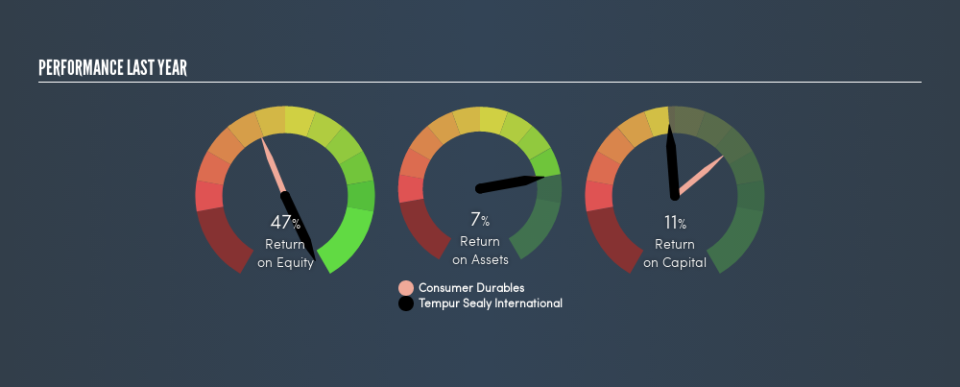What Does Tempur Sealy International, Inc.’s (NYSE:TPX) 11% ROCE Say About The Business?

Want to participate in a short research study? Help shape the future of investing tools and you could win a $250 gift card!
Today we'll look at Tempur Sealy International, Inc. (NYSE:TPX) and reflect on its potential as an investment. Specifically, we'll consider its Return On Capital Employed (ROCE), since that will give us an insight into how efficiently the business can generate profits from the capital it requires.
First, we'll go over how we calculate ROCE. Second, we'll look at its ROCE compared to similar companies. And finally, we'll look at how its current liabilities are impacting its ROCE.
Return On Capital Employed (ROCE): What is it?
ROCE is a metric for evaluating how much pre-tax income (in percentage terms) a company earns on the capital invested in its business. All else being equal, a better business will have a higher ROCE. In brief, it is a useful tool, but it is not without drawbacks. Author Edwin Whiting says to be careful when comparing the ROCE of different businesses, since 'No two businesses are exactly alike.'
How Do You Calculate Return On Capital Employed?
The formula for calculating the return on capital employed is:
Return on Capital Employed = Earnings Before Interest and Tax (EBIT) ÷ (Total Assets - Current Liabilities)
Or for Tempur Sealy International:
0.11 = US$257m ÷ (US$3.0b - US$726m) (Based on the trailing twelve months to March 2019.)
So, Tempur Sealy International has an ROCE of 11%.
See our latest analysis for Tempur Sealy International
Is Tempur Sealy International's ROCE Good?
One way to assess ROCE is to compare similar companies. It appears that Tempur Sealy International's ROCE is fairly close to the Consumer Durables industry average of 11%. Regardless of where Tempur Sealy International sits next to its industry, its ROCE in absolute terms appears satisfactory, and this company could be worth a closer look.
Tempur Sealy International's current ROCE of 11% is lower than 3 years ago, when the company reported a 18% ROCE. This makes us wonder if the business is facing new challenges.
When considering this metric, keep in mind that it is backwards looking, and not necessarily predictive. ROCE can be misleading for companies in cyclical industries, with returns looking impressive during the boom times, but very weak during the busts. ROCE is only a point-in-time measure. What happens in the future is pretty important for investors, so we have prepared a free report on analyst forecasts for Tempur Sealy International.
Do Tempur Sealy International's Current Liabilities Skew Its ROCE?
Liabilities, such as supplier bills and bank overdrafts, are referred to as current liabilities if they need to be paid within 12 months. The ROCE equation subtracts current liabilities from capital employed, so a company with a lot of current liabilities appears to have less capital employed, and a higher ROCE than otherwise. To counter this, investors can check if a company has high current liabilities relative to total assets.
Tempur Sealy International has total liabilities of US$726m and total assets of US$3.0b. Therefore its current liabilities are equivalent to approximately 24% of its total assets. Low current liabilities are not boosting the ROCE too much.
What We Can Learn From Tempur Sealy International's ROCE
This is good to see, and with a sound ROCE, Tempur Sealy International could be worth a closer look. Tempur Sealy International looks strong on this analysis, but there are plenty of other companies that could be a good opportunity . Here is a free list of companies growing earnings rapidly.
If you are like me, then you will not want to miss this free list of growing companies that insiders are buying.
We aim to bring you long-term focused research analysis driven by fundamental data. Note that our analysis may not factor in the latest price-sensitive company announcements or qualitative material.
If you spot an error that warrants correction, please contact the editor at editorial-team@simplywallst.com. This article by Simply Wall St is general in nature. It does not constitute a recommendation to buy or sell any stock, and does not take account of your objectives, or your financial situation. Simply Wall St has no position in the stocks mentioned. Thank you for reading.

 Yahoo Finance
Yahoo Finance 
